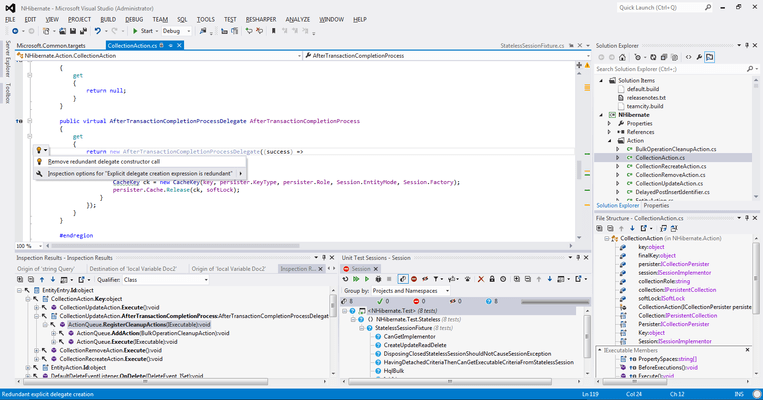


Now it’s time to start CLion and open the project.
Resharper 9 full mega how to#
Check out CLion’s webhelp for details on how to do this. Writing codeįirst of all, the IDE must be configured for embedded development. Note that the toolchain must be set to STM32CubeIDE on the Project Manager tab.Īfter setting all that up, I select the project folder and generate the skeleton of the project by clicking “Generate Code”. quartz oscillator) with internal wake-up enabled SPI1 – transmit-only master mode, Motorola format, 8 bit max speedĪdditional GPIO for the display PA0 as input PA1, PA3, and PA4 as GPIO output I2C1 – standard mode, 100 kHz speed, 7-bit addressĪDC1 – software-triggered Vrefint channel enabled First of all, let’s create a project in STM32CubeMX, select the Nucleo-L432KC board, and then configure all the peripherals: I use STM32CubeMX, the GCC toolchain for ARM and CLion. In this stage, we write the actual firmware for the device. It is worth mentioning that all git manipulations were made right from CLion. I mounted the whole setup on an IKEA tablet stand:Īll the stages from this point on are related to source code, and I make a git commit after each stage so that you can follow along with each change step by step. Note also that the IN+ 5V wire can be removed when we’re finished building and we no longer need to power the ST-LINK interface. The device can be powered and charged by either of two USB ports – one is on the Nucleo board, the other is on the charger – but debugging and flashing can only be done via the Nucleo USB. With these modifications done, I can finally put the circuit together: I solder an extra wire to the 3.3V pin of the sensor chip and fix the wire to the board with hot glue to prevent stress on the solder connection. I use the LDO that comes with the BMP085 module. Now that the on-board power supply is disconnected from the MCU we need to provide an alternative power supply. Below is the board layout from the documentation and the solder bridge map. I’ll also remove SB16 and SB18, as they only provide pin-to-pin compatibility with Arduino but they block the usage of two pins. According to the documentation, the onboard MCU can be powered via a 3V3 pin if the solder bridges SB9 and SB14 are removed. This includes the power LED and the ST-LINK interface. Since I’m aiming for a battery-powered application, I need to disconnect everything extra that consumes electricity from the battery. It contains its own charge/discharge protection circuit, which is always nice to have. They are readily available on eBay and in most electronics and hobby stores.

Let’s use the simplest charger possible – a module based on a TC4056A chip. Unprotected lithium cells can cause fire or explosion if they are short-circuited. If you do use an 18650, make sure to use one with a built-in protection circuit. Any battery would be suitable, for example, an old phone battery or an 18650 cell. I’m going to use a 1000 mAh battery from an action camera. The sensor and the screen can both be powered by either 5V (Arduino) or 3.3V (STM32).Ī single-cell LiPo or Li-ion battery is a good solution to power the device. We’ll use a GY-65 module, though a BMP180 ( GY-68) would do the job just as well. We’ll use the same sensor and screen we used in Part 1:Ī Bosch BMP085 air pressure sensor.
Resharper 9 full mega plus#
Plus lots of other stuff that we won’t need for this project.
Resharper 9 full mega serial#
On-board ST-LINK/V2 debugger/programmer, which allows us to flash our code to the MCU and debug it right on the chip.Ī hardware serial port (UART) connected to a USB-UART bridge, which can be used for diagnostics output. This is what is included in the board and its MCU:Īnalog-digital convertor (ADC) to monitor the battery charge.Īn on-chip RTC with a 32.768 kHz quartz oscillator. I am going to use an ST Nucleo-L432KC board based on the STM32L432 MCU, just because I have one lying around, but there are many different boards that fit the requirements, and the project can be built around any STM32L4-series microcontroller(MCU). We’ll need a real-time clock (RTC), a serial peripheral interface (SPI) interface for the screen, an I2C interface for the weather sensor, and at least 16 KB of RAM, and 64 KB of ROM, all preferably with the lowest possible power consumption.


 0 kommentar(er)
0 kommentar(er)
